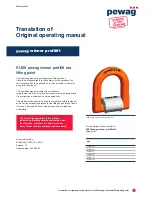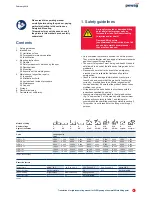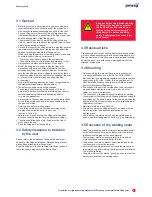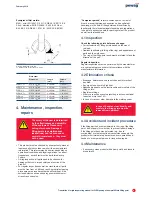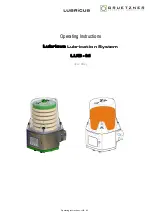
5
Translation of original operating manual for PLEW pewag winner profilift eta lifting point
February 2018
Examples of filler metals:
MAG – wire: ISO 14341: G3 Si 1 / AWS A5.18: ER 70 S-6
Stick – electrode: EN ISO 2560 A: E 42 5 B 4 2 H5 or
E 42 6 B 3 2 / AWS A5.1: E7018-1 / AWS 5.5: E8018-G
4. Maintenance, inspection,
repairs
The safety of the user is determined
by the effectiveness and durability
of the equipment. Please carry
out regular checks. Damaged
lifting points (see maintenance
instructions) can fail even under
normal circumstances – they must
not be used.
• This product must be checked by a competent person at
least annually in accordance with all the manufacturer’s
information. This interval may be shorter, depending on
operational conditions and legal regulations. In case of
frequent use, a crack test must be performed every
2 years.
• During inspection, all parts need to be checked for
damages that could impair safety and function of the
product.
• For regular inspections as well as crack tests, all parts
must be free from oil, dirt and rust. Appropriate cleaning
procedures are procedures that do not overheat, hide
surface defects and cause hydrogen embrittlement or
stress crack corrosion.
Picture 2: Weld seam geometry
x = Distance nap for root seam (2 - 3 mm)
Weld seam
Dimension
Length
[mm]
Volume
[cm
3
]
PLEW 1,5 t
HV 8 +
a3
2 x 35 mm
≈ 3,3 cm³
PLEW 2,5 t
HV 9 +
a3
2 x 41 mm
≈ 4,7 cm³
PLEW 4 t
HV 10 +
a4
2 x 45 mm
≈ 6,8 cm³
PLEW 6,7 t
HV 14 +
a4
2 x 56 mm
≈ 14,9 cm³
PLEW 10
HV 17 +
a5
2 x 61 mm
≈ 24,1 cm³
PLEW 19 t
HV 24 +
a6
2 x 89 mm
≈ 67,5 cm³
“Competent person“
refers to someone who, in view of
his or her expert training and experience, has sufficient
knowledge in the field of lifting points and is sufficiently
familiar with the relevant national standards and regulations
to be able to assess the safe-for-working state of the product
as well as its intended use.
4.1 Inspection
Check the following points before each usage:
• Correct selection of lifting points based on the size of
the load.
• Flawless functioning (folding of the ring) and appearance of
parts and the weld seam.
• The ring of the lifting point used must be rotated to face the
direction of the pull.
Regular inspection:
Regular inspections must be performed by the manufacturer
or a competent person under strict compliance with the
manufacturer’s information.
4.2 Elimination criteria
• Breakage, deformation, sharp notches and/or cracks of
any kind.
• Any sign of exposure to high heat.
• Reasonable doubts on the functionality and/or safety of the
lifting points.
• Illegible markings.
• Wear or excessive corrosion resulting in a cross-sectional
reduction more than 10 %.
• In case of cracks or other damage to the welding seam.
In case of doubts on functionality and/
or safety, the lifting points must be
removed from operation!
4.3 Accident and incident procedure
If the lifting device becomes jammed in the ring of the lifting
point, do not apply force in order to prevent further damage.
If the lifting point becomes deformed (e.g. due to
overloading) or other exceptional circumstances apply, the
product must immediately be removed from operation and
handed to a competent person for inspection/repair.
4.4 Maintenance
• If necessary, clean product with a damp cloth and leave to
dry naturally.

